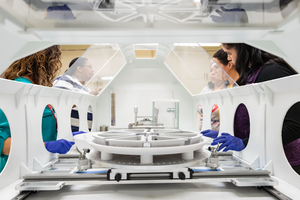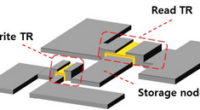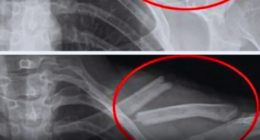NASA’s OSIRIS-REx spacecraft is set to make history by becoming the first United States mission to return an asteroid sample to Earth. The spacecraft is carrying a sample it collected from the rocky surface of asteroid Bennu and is expected to deliver the sample capsule to the Utah desert on September 24. The OSIRIS-REx team is currently testing navigation plans for the capsule using computer models to ensure that it touches down inside the targeted area. Once the capsule arrives, recovery crews will secure the landing site, transport it via helicopter to a portable clean room, and collect soil and air samples around the landing capsule to check for any minute contaminants that may have contacted the asteroid sample. Curation for OSIRIS-REx will take place at NASA’s Johnson Space Center in Houston. The return of the samples collected from asteroid Bennu will mark the beginning of a new phase of discovery for scientists from around the world to analyze this unique and precious material that dates back to the early formation of our solar system.
NASA’s OSIRIS-REx spacecraft is on its way back to Earth carrying the sample collected from asteroid Bennu’s rocky surface. The spacecraft is set to become the first mission in the United States to bring back an asteroid sample to Earth. After seven years in space, the mission is facing one of its biggest challenges yet – delivering the asteroid sample to Earth while ensuring it is protected from heat, vibrations, and earthly contaminants. The sample capsule will parachute down into the Utah desert on September 24.
According to Mike Moreau, deputy project manager at NASA’s Goddard Space Flight Center in Greenbelt, Maryland, “Once the sample capsule touches down, our team will be racing against the clock to recover it and get it to the safety of a temporary clean room.” Therefore, the OSIRIS-REx team will be practicing and refining the procedures required to recover the sample in Utah and transport it to a new lab built for the material at NASA’s Johnson Space Center in Houston over the next six months.
At the Johnson Space Center, scientists will unpack the sample and distribute up to a quarter of it to the OSIRIS-REx science team for analysis, while the rest will be curated for other scientists to study, both now and in future generations. The curation team at the Johnson Space Center will be the first to see and handle the sample, responsible for storing and distributing it to science team members around the world.
NASA’s OSIRIS-REx mission has been an intrepid one, including a nail-biting touchdown on Bennu to gather dust and rocks. However, the mission’s work is not yet done, as it must deliver the asteroid sample safely to Earth.
NASA’s OSIRIS-REx mission is on track to deliver the first-ever asteroid sample to Earth on September 24. Flight dynamics engineers from NASA Goddard and KinetX Aerospace are reviewing the trajectory that will bring the spacecraft close to Earth, while at Lockheed Martin in Denver, team members are preparing for the recovery of the sample capsule. Crews in Colorado and Utah will practice the steps required to recover the capsule safely and protect it from contamination over the summer.
At the Johnson Space Center, the curation team is rehearsing their procedure to unpack and process the sample inside glove boxes, and members of the sample science team are preparing the investigations they will perform once the sample is received. The OSIRIS-REx team has been preparing for this final phase of the mission with extensive training and rehearsals.
Asteroids are the ancient materials left over from the original era of planet formation, and they may contain molecular precursors to life. To understand whether asteroids played a role in delivering these compounds to Earth’s surface over 4 billion years ago, scientists need a pristine sample from space, free from terrestrial contaminants. In addition, the most fragile rocks observed on Bennu probably would not have survived passage through Earth’s atmosphere as meteorites. A pristine sample could provide insights into the development of the solar system.
The sample return capsule is estimated to hold about a cup of Bennu’s material, 8.8 ounces +/- 3.6 ounces (250 grams +/- 101 grams) to be precise, and will land within a 37-mile by 9-mile ellipse (59 km by 15 km) within Department of Defense property that is part of the Utah Test and Training Range and Dugway Proving Grounds as the OSIRIS-REx spacecraft flies by Earth.
“The OSIRIS-REx team has already performed amazing feats characterizing and sampling asteroid Bennu,” said Dante Lauretta, OSIRIS-REx principal investigator from the University of Arizona, Tucson. “These accomplishments are the direct result of the extensive training and rehearsals that we performed every step of the way. We are bringing that level of discipline and dedication to this final phase of the flight operations.”
NASA’s OSIRIS-REx team members are utilizing computer models to test navigation plans for the spacecraft’s capsule carrying samples collected from asteroid Bennu. They are testing various weather, solar activity, and space debris scenarios to ensure the capsule touches down inside the targeted area 13 minutes after it enters Earth’s atmosphere at 10:41 a.m. ET (8:41 a.m. MT).
Recovery crews will secure the landing site of the sample return capsule and transport it via helicopter to a portable clean room at the range. Crews will also collect soil and air samples around the landing capsule to check for minute contaminants that may have contacted the asteroid sample.
Once the capsule is in the portable clean room, the team will remove the heat shield, back shell, and other components to prepare the sample canister for transport to Houston. Curation for OSIRIS-REx, including processing the sample when it arrives on Earth, will take place at NASA’s Johnson Space Center in Houston.
NASA’s Goddard Space Flight Center is providing overall mission management, systems engineering, and safety and mission assurance for OSIRIS-REx. The University of Arizona is leading the science team and the mission’s science observation planning and data processing. Lockheed Martin Space built the spacecraft and provides flight operations. Goddard and KinetX Aerospace are responsible for navigating the spacecraft. The Canadian Space Agency is responsible for the OSIRIS-REx Laser Altimeter instrument, and there is an asteroid sample science collaboration with the Japan Aerospace Exploration Agency’s Hayabusa2 mission. OSIRIS-REx is the third mission in NASA’s New Frontiers Program.
The return of the samples collected from asteroid Bennu will be a significant achievement for NASA and its mission partners, marking the beginning of a new phase of discovery as scientists from around the world analyze this unique and precious material that dates back to the early formation of our solar system.
Don’t miss interesting posts on Famousbio









